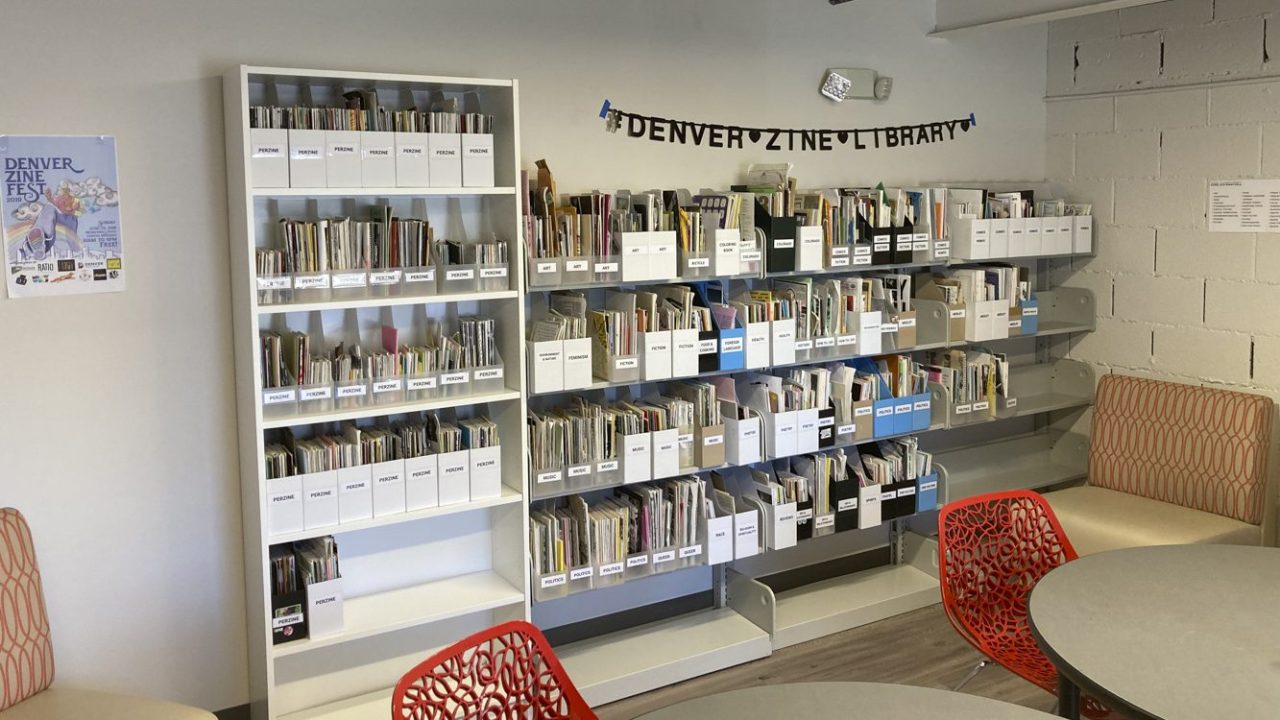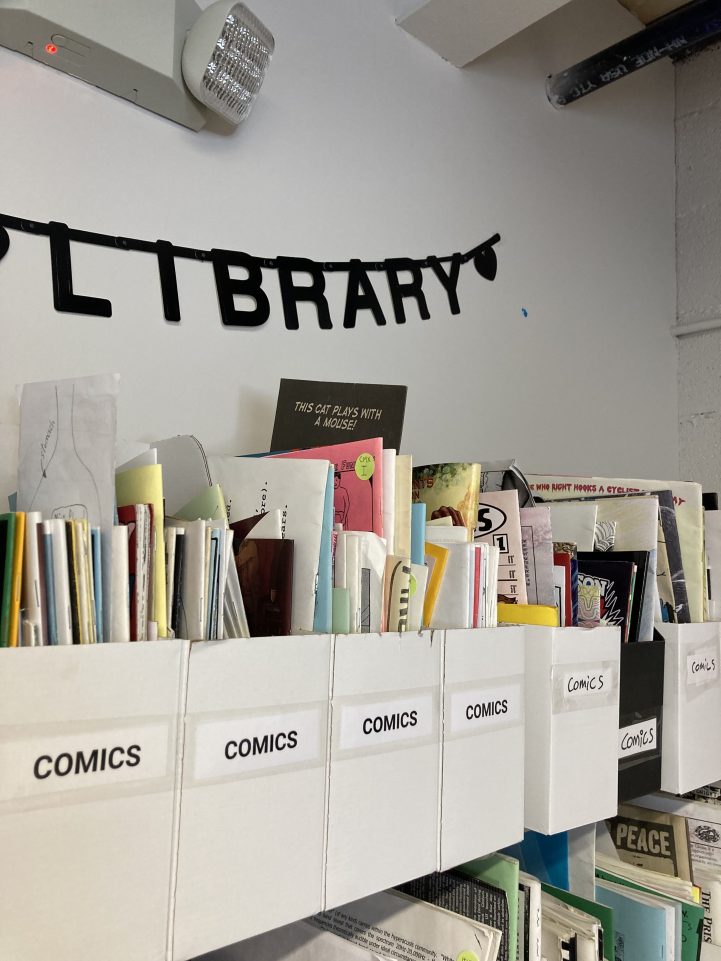
While attending this year’s AAM Annual Meeting in Denver, I stopped by Denver Public Library’s Bob Ragland Branch to visit another, smaller library located within this branch: the Denver Zine Library. My host for the visit was volunteer Hana Zittel, who shared the organization’s history with me, took me through its zine collection, and even provided me with a zine-making tutorial.
For the uninitiated, a zine is a self-published magazine, usually made by hand with nothing but a photocopier and stapler. In that same DIY spirit, the Denver Zine Library maintains itself as an independent non-profit organization, not a Denver Public Library collection. Still, as part of its community commitment, the public library has offered the zine library space in the Bob Ragland Branch at zero cost since February 2022 through a long-term memorandum of understanding.
After my visit, I got to thinking that this model of sharing space might be valuable for museums to consider. Already, there are examples of museums and other cultural organizations that share campuses, buildings, and even resources. There are other examples of one organization serving as the landlord to another, and importantly, this co-mingling of organizational structures is critical and necessary for their survival and their communities’ future success. What if more museums, especially larger ones with space and an interest in community work, took up this idea and began offering needed support and stability to nourish smaller organizations?
To explore this idea more, I sat down for a conversation with Zine Library co-founder Kelly Costello and Denver Public Library Neighborhood Services Director Annie Kemmerling. In the comments, I invite you to share other examples of organizational relationships like this for our learning and awareness.
Adam Rozan: The Denver Zine Library started in 2003, and since then has grown and expanded its collection, reach, and activities in the Denver area. When and how did the Zine Library partner with the Denver Public Library (DPL) and open its location at the Bob Ragland Branch Library?
Kelly Costello: Over the years, formally trained librarians and other staff members from the Denver Public Library have volunteered with the Denver Zine Library. This has been a huge asset to the DZL, as our entire group of volunteers have helped with decisions, policies, and procedures, including donation acceptance, cataloging, lending policies, and more. After several months of discussion and planning, DPL and DZL entered a memorandum of understanding (MOU) as a formal working agreement for the DPL to offer a room in the Bob Ragland branch for the DZL to make the collection available to the public. The DZL maintains separate collection, maintenance, and volunteer policies, and the space is only open to the public when a DZL volunteer is on-site.
AR: As an MOU, no monies are exchanged. Is that correct, and what’s the agreement length between the two libraries?
Annie Kemmerling: No money is exchanged, and the current MOU runs through the end of 2027. The libraries check in annually about the relationship and will reassess a future MOU as the end of the current one approaches.
AR: From the standpoint of the library, since space, even at a new branch, is highly valued, why do this, if no monies are being exchanged for rent and other services?
AK: We view the Denver Zine Library as another great resource we can offer to our customers. The zine library is aligned with our values and saw this as an opportunity to try something different. Bob Ragland has been a location from inception to be a place where we wanted to try unique things. Both the zine library and our neighbor in the building, RedLine Contemporary Art Center, had existing spaces in the neighborhood and we saw this as a way to leverage our resource of space and build relationships with existing organizations.
AR: Housing the Denver Zine Library at the Bob Ragland Library is relatively new. How’s it been going, and how do you staff the zine library? Or is that part of the work of the branch librarians and other library staff?
KC: The Denver Zine Library is a completely volunteer-run organization, so we are able to staff the space during library open hours on Saturdays. It has been great to get more foot traffic from regular library users who are interested in learning more about zines. The space has also allowed us to utilize some of the public meeting spaces in the library location to do programs for the community, including starting up a regular zine club.
AR: Where does the Denver Zine Library sit organizationally in the DPL, meaning, who manages the relationship, and like all things, does the project survive or thrive based on that person and position alone?
AK: Currently the relationship is maintained within our Neighborhood Services Division. Within this division are our branch locations and coordinated services. The relationship was initiated by myself, the director of the division in terms of the agreement facilitation with the Denver Zine Library and the library as a City Agency. On a more day to day basis, the relationship is facilitated by the current branch supervisor and staff team at Bob Ragland. I don’t foresee the project’s survival/thriving based on myself, but certainly do see need for the support of someone in a role like mine. I would be interested in the response of this question from the zine library and what sort of additional supports would be needed. I will say our Bob Ragland location was opened during a turbulent time due to the pandemic and other local and national issues the library was dealing with. As we move forward, we’ll need to work towards more formal check-ins related to the zine library and other things we set out to try at this unique location.
KC: During the open shifts, the Denver Zine Library volunteers interact with the staff at the branch, and we always want to be good neighbors and partners when we’re open for visitors. On a day-to-day basis, we interact most frequently with the Library Branch Supervisor, who has been able to provide information and answer questions as we continue to settle into the space. This has been related to shared expectations, event planning, scheduling and more. Having direct access to the person supervising the branch has made it easy to do informal check-ins, ask questions, and address any concerns as they come up.
AR: Could this model work for other libraries and arts and culture organizations? If yes, what advice would you have for them?
AK: Absolutely! If they are able, try and keep things as simple as you can while setting up guardrails. A reminder that you are co-locating organizations with different cultures and experiences and sharing spaces can be like living with roommates; you have to figure out each other’s habits and day to day negotiating how you co-exist in the same space while reaching each other’s goals.

AR: Since some people reading this might be newer to zines, can you share some zine-based vocabulary words for their awareness?
KC: There’s lots of lingo you might hear around the Denver Zine Library. Here are a few definitions:
- Zinester: A person who self-publishes zines.
- Audiozine: An audio version of a zine. The DZL has a few on cassette and CD. This might be an audio version of a print zine or a unique publication.
- DIY: This acronym for “do it yourself” is becoming more mainstream and used throughout crafting, construction, and other communities.
- Fanzine: A zine about fandom, which can include books, tv, movies, music, or other types of media.
- Perzine: This genre of personal zines often contain first-person, narrative writing, and may include journal-type musings, recipes, doodles, opinions, and more.
- Long-arm stapler: The adjustable stapler that allows for binding along the spine of a zine that is too deep for a standard stapler to reach.
Adam Rozan: Most libraries follow the American Library Association and Library of Congress cataloging system, but the Denver Zine Library doesn’t, so what method does it use, and why?
KC: The DZL was founded by zinesters and fans of zines, but did not have any formal training in cataloging systems and did not have a budget for cataloging software. The team created a catalog in Microsoft Access to capture the pieces of information they felt would be most important for searching the catalog as well as locating specific zines on the shelves. For most of the history of the organization, the catalog has remained in Access, and we are currently in the process of transitioning to TinyCat.
There is also a movement among zine libraries to create a union catalog. From Zinecat.org: “A union catalog is a resource where libraries can share cataloging and holdings information. The Zine Union Catalog (ZineCat) lets researchers discover zine holdings by searching a single catalog, and helps librarians copy catalog records to facilitate lending across libraries. ZineCat serves educators, researchers, librarians, archivists, and anyone in the general public with an interest in zines.” One of the interesting challenges of creating a union catalog is how to capture collections that use a range of systems, including Library of Congress, MARC records, the Dewey Decimal System, and unique catalogs as well. Zine libraries exist all over the world, sometimes within larger collections in public or academic libraries, as stand-along nonprofits, or the living rooms of punk houses.








